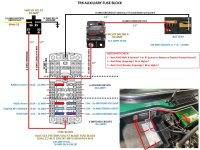PGSberg
Freshman Member
Offline
1975 TR6. I am contemplating installing a auxiliary circuit so not to tax the existing aging wiring. I’ve read, read and read, and think I have a winter project plan. I’d like a sanity check from you experts out there before I set my car on fire. LOL. I’m pretty sure some of the OEM wiring may have been replaced with other colored wire therefore I’d rather not mess with what is working until I learn more and sort that out.
For planning, my attached diagram has more accessories than I would need.
1 - I'm not installing a killer stereo with amps and speakers mounted on the trunk or off road lights. Best AWG for the main electric/ground? Best to Ground to battery or to the Battery Ground on the Firewall?
2 - Proper AMP Relay for the Switched Circuit?
3 - Proper AMP for Circuit Breaker?
4 - Haven't looked under the dash so hope the ACC blade is well marked on the ignition switch or is there a better location in the engine compartment?
I’m not an auto electrician by any means. Thanks for constructive feedback.
For planning, my attached diagram has more accessories than I would need.
1 - I'm not installing a killer stereo with amps and speakers mounted on the trunk or off road lights. Best AWG for the main electric/ground? Best to Ground to battery or to the Battery Ground on the Firewall?
2 - Proper AMP Relay for the Switched Circuit?
3 - Proper AMP for Circuit Breaker?
4 - Haven't looked under the dash so hope the ACC blade is well marked on the ignition switch or is there a better location in the engine compartment?
I’m not an auto electrician by any means. Thanks for constructive feedback.

 Hi Guest!
Hi Guest!

 smilie in place of the real @
smilie in place of the real @
 Pretty Please - add it to our Events forum(s) and add to the calendar! >>
Pretty Please - add it to our Events forum(s) and add to the calendar! >> 

